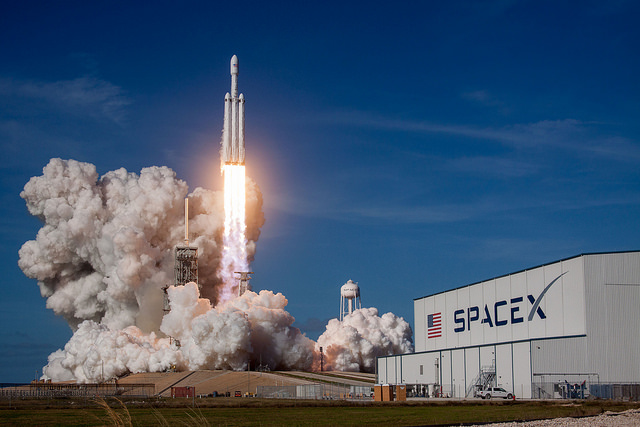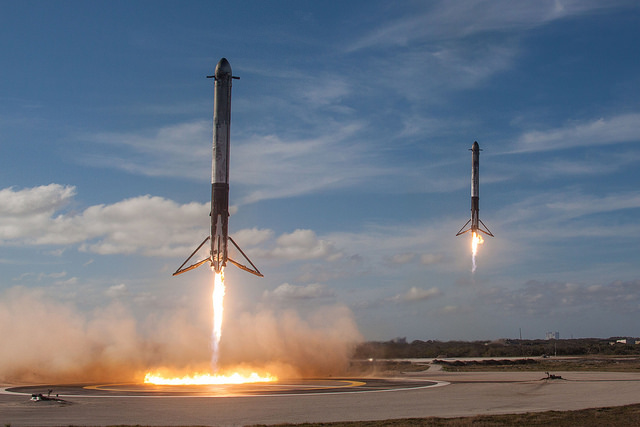FALCON HEAVY FACT SHEET
By Cliff Lethbridge

Falcon Heavy Launch, Photo Courtesy SpaceX
Classification: Space Launch Vehicle
Length: 229.6 Feet
Diameter: 39.9 Feet
Date of First Cape Canaveral Launch: February 6, 2018
Date of Final Cape Canaveral Launch: Active
Number of Cape Canaveral Launches: Active
The Falcon Heavy is a composite vehicle comprised of three Falcon 9 first stage boosters strapped together. With a total of 27 Merlin engines firing at launch, the Falcon 9 can produce 5.13 million pounds of thrust, making it the world’s most powerful launch vehicle. Historically, the Falcon Heavy is second only to the mighty Saturn V in liftoff thrust. The Saturn V produced 7.5 million pounds of thrust at launch. The Falcon Heavy may eventually yield to NASA’s massive Space Launch System (SLS) rocket in terms of total liftoff thrust. SLS is designed to have a liftoff thrust of over 8 million pounds. Fully fueled, the rocket has a total mass of 3.125 million pounds at launch. The rocket can carry a composite fairing or a Dragon capsule, depending on mission requirements. Like the Falcon 9 rocket, the Falcon Heavy first stage and second stage burn a combination of liquid oxygen and RP-1 (kerosene) fuel.
With the capability of carrying a maximum 140,600 pounds of payload to Low Earth Orbit, the Falcon Heavy performance is far and above that of comparable launch vehicles. Payload capability to Low Earth Orbit of the Falcon Heavy is roughly three times greater than the Space Shuttle and Delta IV Heavy, and roughly four times greater than the Atlas V. The Falcon Heavy can also carry a maximum 58,860-pound payload to Geostationary Transfer Orbit, a maximum 37,040-pound payload to Mars or a maximum 7,720-pound payload to Pluto. In a typical flight scenario, the outer two boosters are recovered via a landing at Cape Canaveral Air Force Station Landing Zone 1, which now has two landing pads to accommodate Falcon Heavy requirements. The center booster is recovered on a barge located in the Atlantic Ocean several hundred miles east of Cape Canaveral. The Falcon Heavy performed nearly flawlessly on its maiden flight on February 6, 2018. The only anomaly was the failure of the center booster to be recovered. Both outer boosters successfully landed at Landing Zone 1. The rocket carried a Tesla Roadster automobile on a deep space trajectory.

Falcon Heavy Outside Boosters Landing, Photo Courtesy SpaceX


